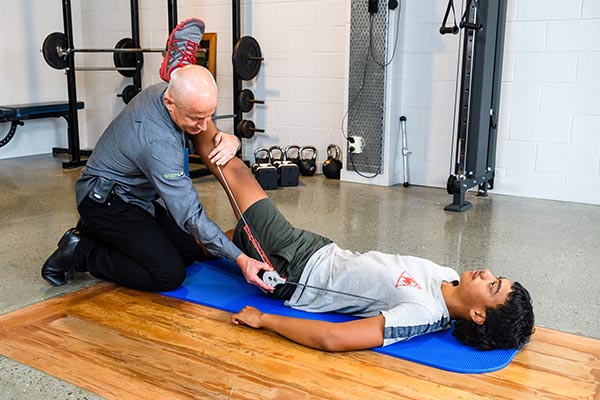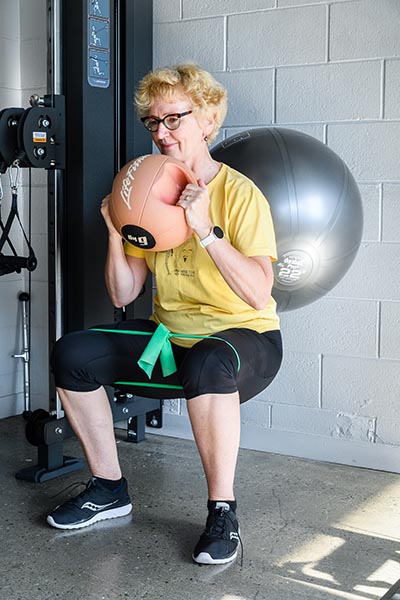A recurring physiological pattern has been observed with Long COVID-Chronic Fatigue-Vaccine Injury cases which points to the mitochondria as the root of the issue. Once identified it is possible to reverse the dysfunction14.
First, we can look at the physiology of a healthy person during a graded exercise test using a research grade metabolic cart (Vacumed). The graph below shows a subject (male) with very good metabolic flexibility2 ie. very good at using fat for fuel and very good at using carbohydrate for fuel. Fat metabolism dominates at lower levels of exertion until lactate threshold gets closer when carbohydrate starts to dominate. The graph represents this by the gap between the green line (O2) and blue line (CO2). More CO2 is produced with carbohydrate metabolism which brings those two lines closer together at higher workloads. Optimal is to still be using 60% fat fuel at lactate threshold1. This subject was using 63% fat fuel at this point. This all happens within the mitochondria and therefore reflects the health of the mitochondria.
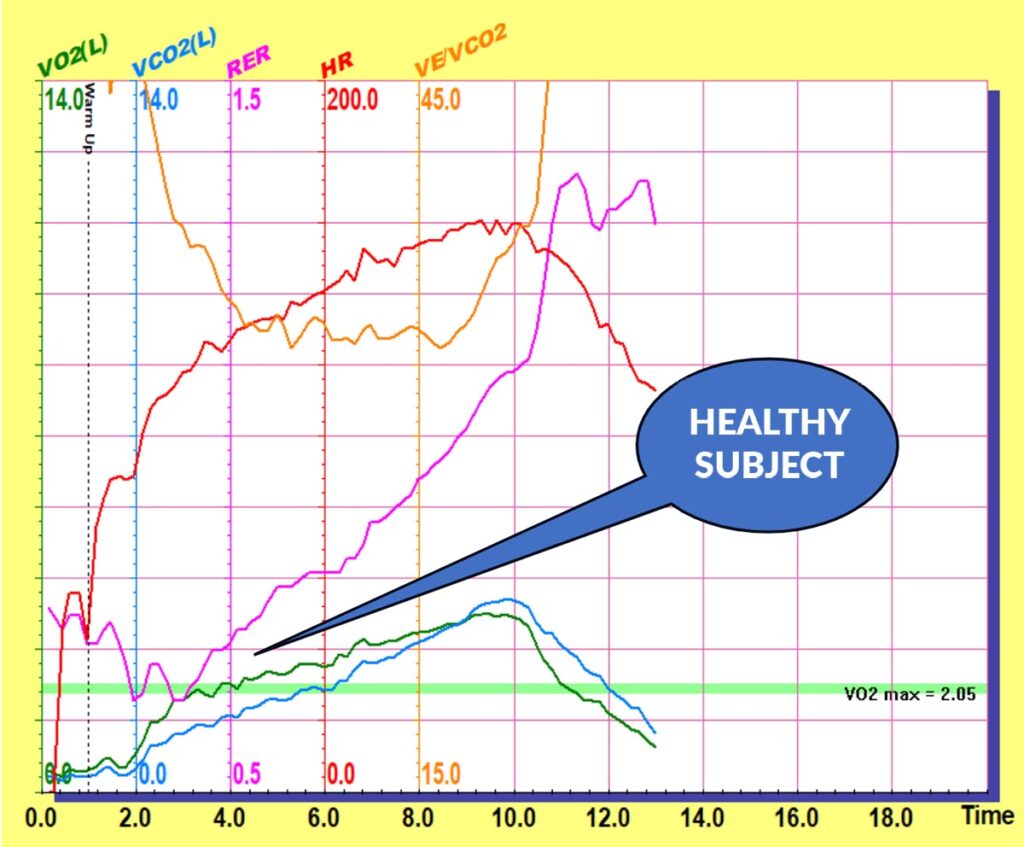
The four graphs below show a significantly different pattern ie. a dominant sugar burning pattern, a very low lactate threshold and a very low VO2max score which makes it very difficult to do activities of daily living.
- Case A, is a 37 year old female with COVID vaccine injury/chronic fatigue symptoms who was on ACC for a COVID vaccine injury claim. Her VO2max (23.04ml/kg/min) came out at the 1st percentile for age and gender.
- Case B, is a 60 year old female with Long COVID/Chronic Fatigue. Her VO2max (22.97ml/kg/min) came out at the 5th percentile for age and gender.
- Case C, is a 33 year old female with a Vaccine Injury/Chronic Fatigue. Her VO2max (25.85ml/kg/min) came out at the 5th percentile for age and gender.
- Case D, is a 45 year old female with a Vaccine Injury/Chronic Fatigue. Her VO2max (30.02ml/kg/min) came out at the 25th percentile for age and gender.
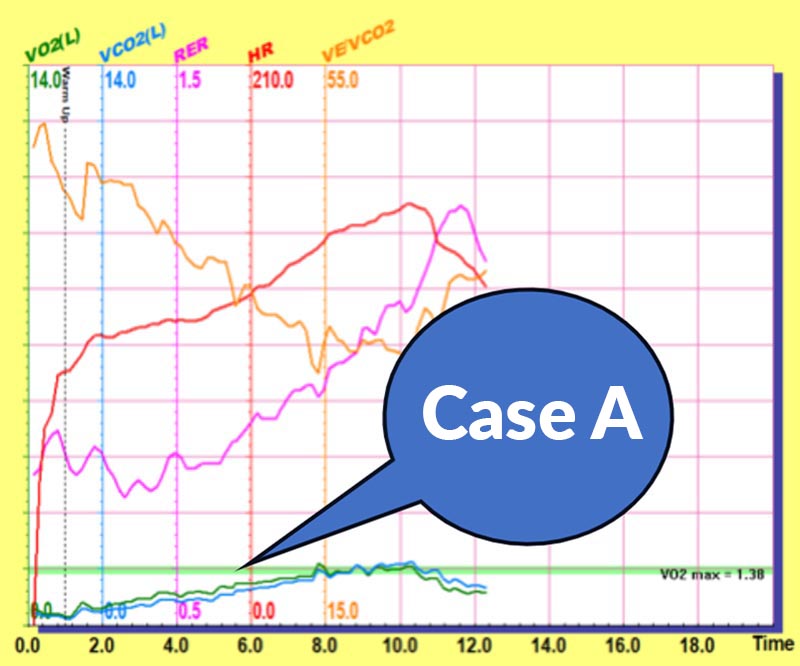
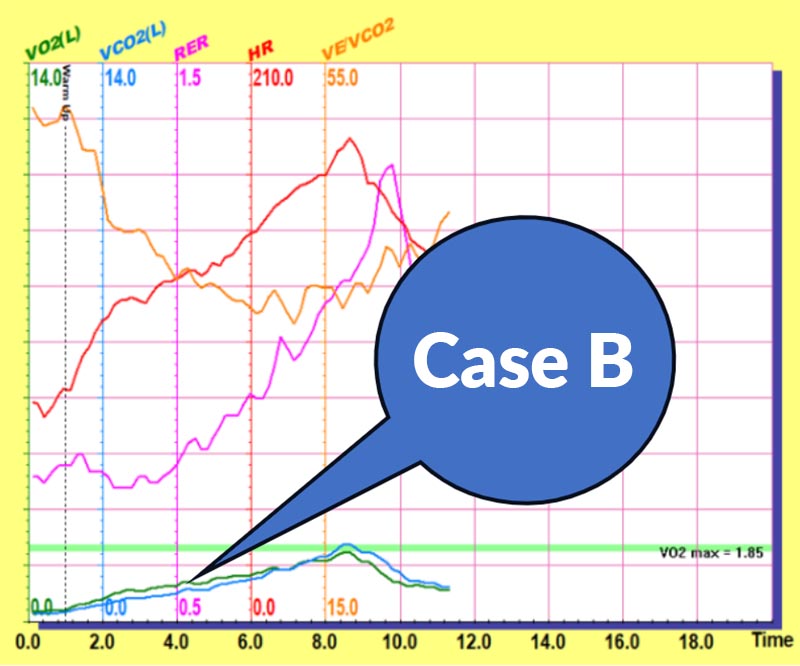
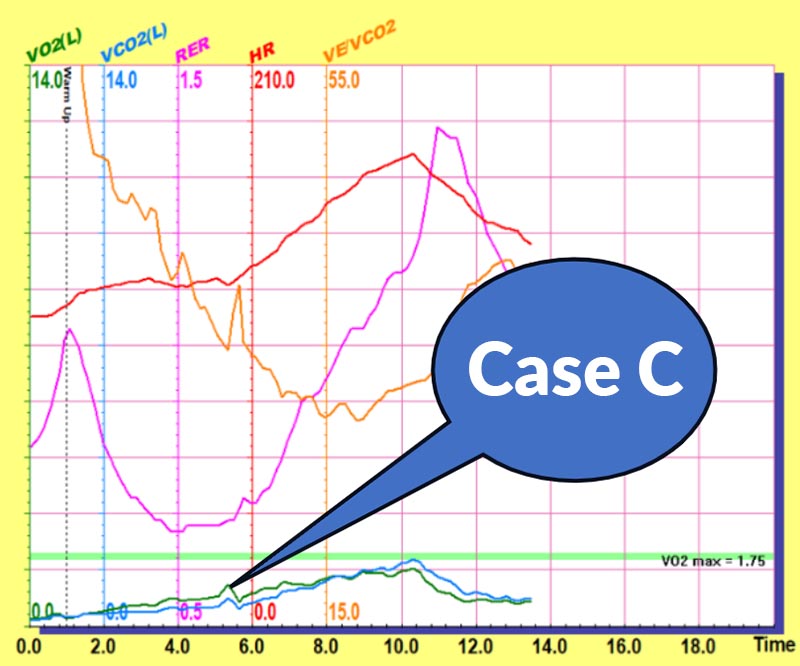
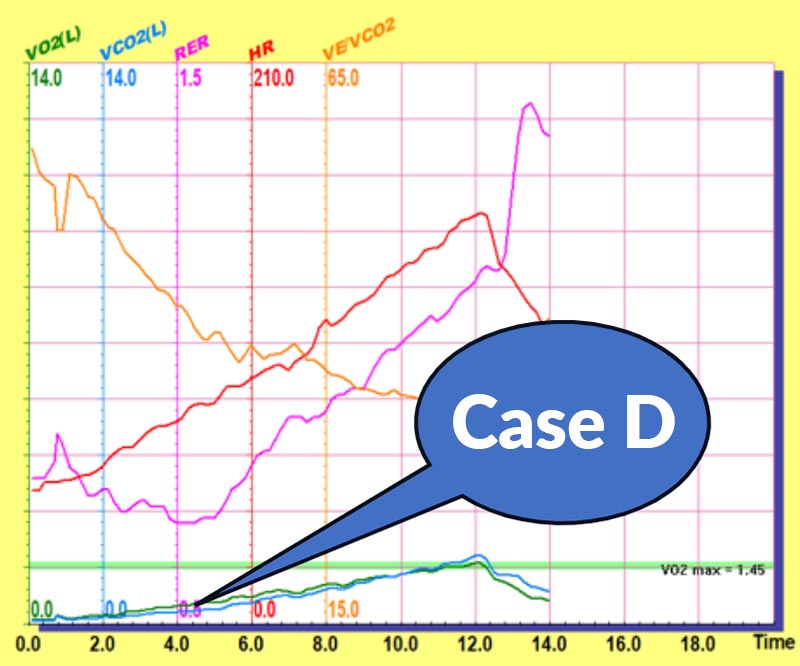
As mentioned, in all cases, the lactate threshold is at a very low workload. This means it only takes a low level of work to go above this threshold at which time the production of lactate increases, and this then further inhibits the mitochondria3 because they are having trouble using oxygen efficiently14. This makes exercise a very poor solution initially.
The findings above give us a significant clue that mitochondria are at the root of energy issues. This is also supported by what researchers have already uncovered regarding the link between the virus and mitochondrial damage14,15.
An extra piece of the puzzle that needs to be included is the work by Dr Robert Naviaux7. He has brought light on the dual function of the mitochondria. They not only have an energy production role (ATP) but also have a signalling role. If the environment in the body is not safe, the mitochondria will turn on the cell danger response and dial down energy production for survival. If the environment remains unsafe, the cell danger response will remain switched on. It is probable that this switch has remained on in all cases mentioned above.
The good news is that there is a way to switch off the cell danger response and return the mitochondria to healthy function again. Work by Dr Sarah Myhill3 and Ari Whitten6 has shown great success when a much more comprehensive approach is taken. In brief it can look like this as a step-by-step process.
- Start with the gut (assume2 or measure for leaky gut2 / dysbiosis and repair; measure Vitamin D and optimise; measure insulin resistance and optimise – consider Inositol; measure for inflammation and optimise – consider the Galectin-312 blocker PectaSol9; consider intermittent fasting and Augmented NAC10,11 to remove 99.8% of spike proteins11; consider Quercetin to calm down Mast Cell Activation; consider nose breathing to calm the nervous system; consider Arterosil, Nattokinase, Serrapetase, or Lumbarkinase to address microclotting and consider Vinia to enhance blood flow; measure additional energy related markers eg. B12/Folate, RBC Magnesium, Iron Panel, Complete Blood Count…and optimise; plus optimise all detox pathways – consider Tudka, Ox Bile, Milk Thistle) and circadian rhythm. Also provide support for oxidative stress in the mitochondria at this point, with melatonin (available in pistachio nuts as well), Augmented NAC mentioned above and Alpha-Lipoic Acid to have additional benefits on nerve cells.
- Hormesis to create more mitochondria (not exercise at first eg. red light therapy, infrared sauna, hypoxic breathing, PEMFT)
- Give the mitochondria the fuel and nutrients they prefer (eg. ketones, CoQ10, PQQ, L-carnitine, Urolithin A, Energenesis, creatine, B vitamins, magnesium, NMN, D-Ribose, zinc, copper)
- Support the thyroid for optimal function (include a full thyroid panel blood test ie. TSH, Free T4, Free T3, TPO antibodies, consider supplementing with T2 thyroid supplement)
- Support the adrenals for optimal function (include a DHEA-S blood test and morning cortisol)
If you happen to take a Statin or a Proton Pump Inhibitor (PPI), you are slowing down energy production2. Statins not only reduce cholesterol, they also down regulate the Geranylgeraniol or GG pathway that includes the production of CoQ10, an essential co-enzyme needed for ATP (energy) production. The PPI’s (eg. Omeprazole) not only affect the proton pumps in your stomach, they also affect them in your mitochondria. The net result is less energy. These PPI’s can also cross the blood brain barrier and poison your mitochondria. They can influence brain fog, cognitive slowdown, and dementia. This is worth a conversation with your doctor if you are on these drugs.
If you have got to this point you may have some level of enthusiasm for the step-by-step process if you are suffering. If that is you, please go for it. However, you may be someone who feels you do not have the energy for such a process as nothing has worked for you up to this point and you are wondering if there is a faster way. If you are this person, this part is for you. It is about the research on Nicotine, put together by Dr Bryan Ardis D.C13. It all goes back to April 2020 when French Researchers identified the spike proteins of the COVID virus were identical to two snake venom proteins that are neurotoxins. They were able to show that these proteins target the nicotine receptors which are throughout the body. You can read the paper at this link… https://comptes-rendus.academie-sciences.fr/biologies/item/CRBIOL_2020__343_1_33_0/ . This was confirmed by a NIH funded and published study in May 2023. You can read the paper here…. https://www.jbc.org/article/S0021-9258(23)01735-0/fulltext . This led to research on long COVID patients using 7mg nicotine patches. Improvements ranged from immediate to complete remission in just 6 days. You can read the paper here…. https://bioelecmed.biomedcentral.com/articles/10.1186/s42234-023-00104-7 . Should you decide that you want to give this a go, here are two protocols to choose from:
- Purchase and wear one 7mg Nicotine Patch daily for 1 week minimum and then continue until symptoms abate.
- Purchase 2mg Nicotine Gum and chew one 2 mg gum tablet for 10 minutes, 4 times per day for 2 weeks until symptoms resolve and then continue until symptoms abate. If you have any reactions to this option, change to the nicotine patch option.
If you would like to look at more research on this evolving topic, there are now 660 published papers on COVID and Mitochondrial Dysfunction. You can find them here….. https://pubmed.ncbi.nlm.nih.gov/?term=COVID+and+mitochondrial+dysfunction
References
- Shallenberger, Frank (2007). Bursting with Energy.
- Gundry, Steven (2021). The Energy Paradox
- Myhill, Sarah (2024). Diagnosis and Treatment of Chronic Fatigue Syndrome and Myalgic Encephalitis.
- Whitten, Ari (2018). The Ultimate Guide to Red Light Therapy.
- Pawluk, William MD (2021). Supercharge Your Health with PEMF Therapy
- Whitten, Ari (2023). https://theenergyblueprint.com/
- Naviaux, Robert K (2014). Metabolic features of the cell danger response. Mitochondrion . May:16:7-17
- Girardot, Marc (2024). The Needle’s Secret. Unraveling the Mystery of Vaccine Harm.
- https://econugenics.com/pages/pectasol-mcp-shop?utm_source=sponsorship&utm_medium=email&utm_campaign=lcvdgordonforum#s-0e5e2926-508d-4c7f-9571-98199580ae23
- https://return2health.nz/brands/augmented-nac?srsltid=AfmBOopihMHrntkoN_l0BZlSgc7-4TJhgmAF6F_cjWGaMZxhlLHyfAMV
- https://zerospike.org/wp-content/uploads/2023/03/ZEROSPIKE-PROJECT-BROCHURE.pdf
- https://pmc.ncbi.nlm.nih.gov/articles/PMC7536583/
- https://thedrardisshow.com/free-resources
- Groysman, Robert MD (2025). The Complete Long COVID Handbook, Mitochondrial Dysfunction Volume 3.
- https://www.drgalland.com/longcovid
Brendan Roach M.Sc, B.Ph.Ed, CHEK II, ISAK III, FNC
Exercise Physiologist/Director
info@bodylab.co.nz


